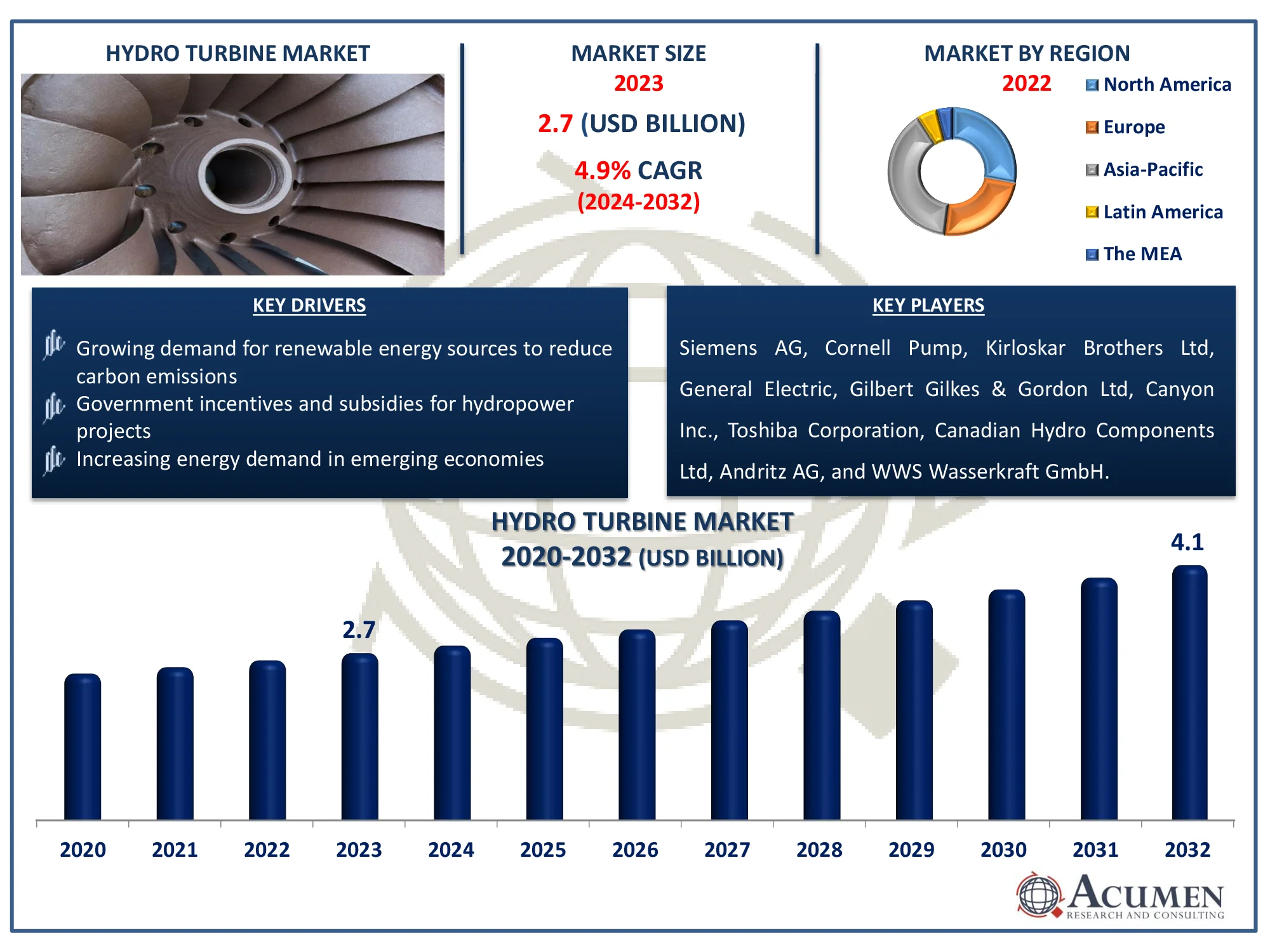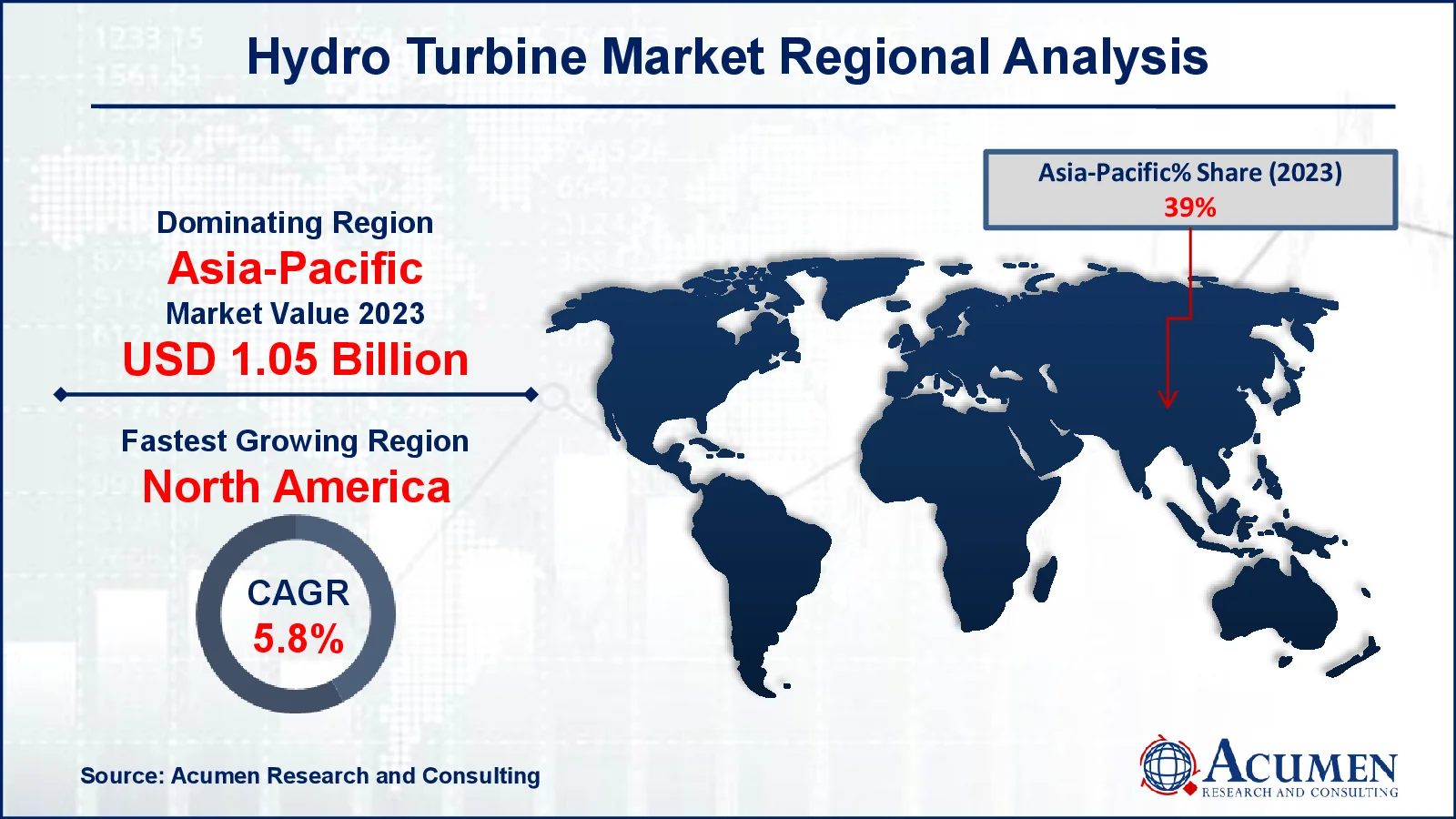July 2020
Explore the expanding Hydro Turbine Market, projected to grow from USD 2.7 billion in 2023 to USD 4.1 billion by 2032, with a CAGR of 4.9%. Gain insights into market trends and forecasts in this essential renewable energy sector.
The Global Hydro Turbine Market Size accounted for USD 2.7 Billion in 2023 and is estimated to achieve a market size of USD 4.1 Billion by 2032 growing at a CAGR of 4.9% from 2024 to 2032.
Hydro Turbine Market (By Type: Reaction Turbine (Kaplan Turbine, Bulb Turbine, Francis Turbine ) Impulse Turbine (Cross Flow Turbine, Pelton Turbine ); By Installation Type Large Hydro Plants (more than 500 kw)Mini Hydro Plants (100 kw – 500 kw), Micro Hydro Plants (5 kw – 100 kw), and Pico Hydro Plants (0 kw – 5 kw); By Head Type: High Head (300 m to 1500 m), Medium Head (30 m to 300 m), and Low Head (Less than 30 m) and By Region: North America, Europe, Asia-Pacific, Latin America, and MEA)
Hydro Turbine Market Highlights

Hydro turbines are electromechanical devices that generate electricity in hydropower projects. Hydro turbines use moving water to generate electricity by rotating a shaft. The turbines rotate or revolve in response to the water in their blades. Hydro turbines are vital in the field of hydropower (the process of generating electricity with water). The turbine structure is often straightforward. The plate or spinning shaft is fitted with a row of blades, which circulate water across the blades, causing the inner shaft to rotate. The rotational motion is transferred to a generator, which produces electricity. The type of turbine used in hydroelectric facilities is determined by the volume of flowing water (known as the hydroelectric discharge) and the height of the water storage (known as the hydraulic head). Cost and efficiency must also be taken into consideration.
Global Hydro Turbine Market Dynamics
Market Drivers
Market Restraints
Market Opportunities
Hydro Turbine Market Report Coverage
| Market | Hydro Turbine Market |
| Hydro Turbine Market Size 2022 |
USD 2.7 Billion |
| Hydro Turbine Market Forecast 2032 | USD 4.1 Billion |
| Hydro Turbine Market CAGR During 2023 - 2032 | 4.9% |
| Hydro Turbine Market Analysis Period | 2020 - 2032 |
| Hydro Turbine Market Base Year |
2022 |
| Hydro Turbine Market Forecast Data | 2023 - 2032 |
| Segments Covered | By Type, By Installation Type, By Head Type, And By Geography |
| Regional Scope | North America, Europe, Asia Pacific, Latin America, and Middle East & Africa |
| Key Companies Profiled | Siemens AG, Cornell Pump Co, Kirloskar Brothers Ltd, General Electric Co., Gilbert Gilkes & Gordon Ltd, Toshiba Energía AG, Canyon Inc., Canadian Hydro Components Ltd., Andritz AG, and WWS Wasserkraft GmbH. |
| Report Coverage |
Market Trends, Drivers, Restraints, Competitive Analysis, Player Profiling, Covid-19 Analysis, Regulation Analysis |
Hydro Turbine Market Insights
Renewable energy demand in emerging economies is likely to rise, providing hydro turbine makers with a promising chance for expansion. In the next years, emerging markets could provide a significant growth opportunity for renewable energy. Hydropower is becoming a more popular power source due to its competitiveness in countries that need to increase productive capacity to maintain economic growth rates. Technology flexibility also makes hydraulic projects more competitive, especially in emerging economies where grid connection is difficult for direct distribution to companies and industries.
One of the most significant barriers to the growth of the hydro turbine market is environmental concerns. Upstream flows are captured behind a reservoir in hydropower plants, reducing downstream river flows. Furthermore, lowering river flow can harm plant and animal habitats by altering water temperatures. The drop in oxygen levels in the river may also have an impact on water quality. Furthermore, the consequences of hydropower on water and downstream riparian rivers include diversion of natural river flows. These factors impede the expansion of the renewable energy sector's hydro turbine market.
Retrofitting and upgrading outdated hydropower infrastructure creates a substantial potential for the hydro turbine market by increasing the efficiency and performance of current facilities. For instance, according to the Department of Energy, a report identifies opportunities for hydropower to capitalize on advanced manufacturing. In March 2023, Oak Ridge National Laboratory published a report on how modern materials and manufacturing could benefit the hydropower business. The report investigates how innovative materials can reduce operating costs and improve the efficiency of the country's current hydropower fleet and future projects. Many hydroelectric facilities worldwide are decades old, resulting in inefficiencies and higher maintenance costs. By replacing or updating outdated turbines with contemporary, more efficient models, energy output can be maximized without the need for additional dams, reducing environmental impacts.
Hydro Turbine Market Segmentation
The worldwide market for hydro turbine is split based on type, installation type, head type, and geography.
Hydro Turbine Types
According to the hydro turbine industry analysis, the reaction turbine leads industry due to its capacity to efficiently transform hydraulic energy into mechanical energy in both high and low-head applications. Its enclosed design allows water pressure to act on both the rotor blades and the casing, making it appropriate for a variety of water flow situations. This adaptability, combined with better energy conversion rates, makes it ideal for many hydroelectric power facilities. Reaction turbines are widely employed in large-scale hydroelectric projects like dams.
Hydro Turbine Installation Types
Large hydro plants (greater than 500 kW) anticipated to dominate the hydro turbine industry because they can generate significant volumes of electricity, making them critical for national grids and large-scale power needs. These facilities benefit from economies of scale, which result in more efficient energy production and long-term cost-effectiveness. Their widespread use in major dams and reservoirs enables reliable, high-output power generation, which is critical for addressing global energy demands.
Hydro Turbine Head Types
According to the hydro turbine market forecast, the medium head type (30 m to 300 m) dominates the market because it achieves an ideal balance of flow rate and water pressure, making it suited for a wide range of hydroelectric projects. These turbines, which commonly include Francis turbines, are appropriate for river and dam projects with moderate head heights. Their adaptability enables them to work successfully in a variety of geographical and environmental conditions, which contributes to their widespread use in hydroelectric power generation.
Hydro Turbine Market Regional Outlook
North America
Europe
Asia-Pacific
Latin America
The Middle East & Africa

Hydro Turbine Market Regional Analysis
For several reasons, the hydro turbine market dominates Asia-Pacific and South America. The Asia-Pacific hydro turbine market is estimated to expand the most in terms of both value (USD) and volume (Units) during the forecast period. As a result of increased government initiatives to alleviate frequent power outages, the market in Asia-Pacific has grown significantly. In the near future, China and India are expected to be important market drivers. Furthermore, the project's operation and development are expanding since hydropower generating emits no air pollutants or other global warming gases, thereby increasing hydro turbine demand for electricity, particularly in emerging economies. The advantage of hydropower over wind power is that water is denser than air; therefore turning the turbine in a hydropower system takes more wind force than water to gather mechanical energy from the wind. As a result, emerging countries prioritize hydropower projects, which fuel the need for hydro turbines.
Moreover, marine and hydrokinetic systems (MHK) convert ocean and river current energy into electricity. MHK technologies in coastal loading hubs have a considerable potential to supply renewable energy to consumers and are predicted to provide enormous prospects for the hydro turbine sector.
Hydroelectric projects in saturated markets like Europe and North America are more likely to use technologically advanced equipment. These also provide hydro project owners with cutting-edge technologies such as phone apps, drones, and computer models.
Hydro Turbine Market Players
Some of the top hydro turbine companies offered in our report include Siemens AG, Cornell Pump Co, Kirloskar Brothers Ltd, General Electric Co., Gilbert Gilkes & Gordon Ltd, Canyon Inc., Toshiba Corporation, Canadian Hydro Components Ltd, Andritz AG, and WWS Wasserkraft GmbH.
Looking for discounts, bulk pricing, or custom solutions? Contact us today at sales@acumenresearchandconsulting.com
July 2020
March 2024
May 2024
April 2021